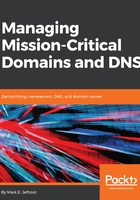
Introducing resolvers
The two main variants of nameservers represent both sides of a DNS lookup process: a query (resolver) and a response (authoritative nameserver).
Remember my original "elevator pitch" about how DNS works:
"Every time you send an email, visit a web page, type or receive an instant message, text, or SMS, place a VoIP call (or Skype), or anything else involving the internet, it cannot happen until a bunch of computers around the internet have a conversation about it: Where does this email need to be delivered to? What server is holding the file that this web browser is asking for? Where is the VoIP gateway that needs to route this call?"
The computers, or applications or daemons that are actually asking these questions are the resolvers.
Your clients are more often applications such as web browsers or email clients, than they are people. Those clients are querying their local resolvers who are asking your authoritative nameservers for answers. Then they will send those responses back to their clients.

Before those resolvers can query your nameservers, they have to find out which authoritative nameservers they should query for each hostname, resource record (RR), or domain that they need to look up. We'll look at that process in the Anatomy of a DNS query next.